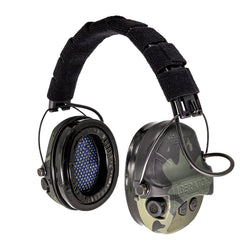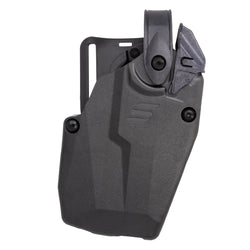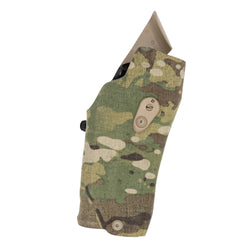In spite of the advances of semi-automatic pistol technology, small hammerless revolvers continue to sell well. In tight quarters at high speeds, the revolver continues to excel thanks to its lack of a reciprocating action and simple manual of arms.
There are many different revolvers to pick from for the role of a primary or backup gun, but you do not have to ride with Roscoe to do it in style. One of the best carry revolvers on the market is the unconventional Ruger LCR. This polymer-framed wheelie wonder is one of the latest innovations in revolver design. Chambering it in 9mm Luger changes the dynamic even more.
Here is a take on the Ruger LCR 9mm as a candidate for concealed carry and as a backup gun for the LEO role.
The Rundown on the LCR 9mm
Revolvers are traditionally dense, all-steel handguns. Even lightweight models that feature aluminum or scandium frames are mostly steel. Indeed, some parts of a revolver did not require metal at all in order to be solid.
Ruger figured it out and introduced it in 2008 as the Lightweight Compact Revolver in .38 Special. It weighs just 13.8 ounces and uses a glass-filled polymer grip frame and hammer shroud to house the fire control unit, while an aluminum subframe houses the cylinder, barrel, and other pressure-bearing parts. The addition of a Hogue Tamer grip and a cam-bearing trigger made for a smoother shooter with less felt recoil to boot.

The LCR has been made in calibers ranging from .22 LR to .357 Magnum, and all are worthy of consideration, but the 9mm version built on the .357 frame is particularly compelling.
Like the original model, the LCR 9mm has a polymer grip frame and shroud over the concealed hammer. The Hogue Tamer grip and 1 7/8 inch stainless steel barrel are retained, as is the deeply fluted steel cylinder. The sights consist of a fixed rear notch milled into the cylinder frame and a pinned white-out front blade.
Unlike the .22 and .38 versions, the 9mm version uses a steel subframe. This increases the weight of the LCR, but what it got in exchange is 9mm chambering.
The Ruger LCR originally debuted as a double-action-only revolver with a concealed hammer, but it has since been offered with an exposed hammer and a version with a longer three-inch barrel. For the concealed carry and backup role, I purchased the original DAO model.
Ruger LCR 9mm Quick Specs
- Caliber: 9mm Luger
- Capacity: 5
- Barrel Length: 1.9 inches
- Overall Length: 6.5 inches
- Width: 1.25 inches (at the cylinder)
- Height: 4.6 inches
- Weight: 19.4 ounces (loaded)
The Why Behind a 9mm Revolver
Traditionally, revolvers of this size employed for self-defense are generally chambered in rimmed revolver cartridges like .38 Special or .357 Magnum.
With a short-barreled handgun like the LCR, the .38 Special loses enough power to the point that some ammunitions fail to perform adequately. A snubbie in .357 solves the performance problem, but the user is rewarded with more recoil and blast, making accurate shooting and fast follow-up shots difficult.
Reloading revolvers in either cartridge quickly calls for speedloaders, which take more technique to use effectively. These longer cartridges are harder to load and harder to eject once fired, thanks to the short ejector rods on small revolvers.
Furthermore, if you are in law enforcement, it might not be practical to practice and carry a .38 or .357 when most departments authorize the issue of 9mm handguns.
In a revolver, the 9mm Luger does not lose as much performance as a .38 does when going from a service handgun to a compact model. The shorter rimless cases are easy to load and eject, while the use of moon clips to feed the rounds acts as a handy reloading device.
Logistics is also simplified, as you can supply the same ammunition you use in your primary pistol and allocate some for your backup gun.

On the Range With the Ruger LCR 9mm
The Ruger LCR 9mm gives the user a proven low-drag platform in a caliber that is cheap, available, and quickly becoming standard.
But how does it perform on the range, and does the use of the 9mm Luger round truly make it better than the other versions?
To that end, I pocketed the LCR in a Safariland Model 25 Pocket rig, packed up 300 rounds of 9mm ammunition, and headed to the range to see what I could learn.
Ergonomic Impressions
The features of the Ruger LCR won’t win it a beauty contest, but they do make it among the easiest small revolvers to handle. This is my third LCR, and the same great features are true for this one as with the others.
Trigger, Grip, and Recoil Management
The friction-reducing cammed trigger makes for a smooth pull, and the polymer subframe provides plenty of weight savings. That savings normally translates into more felt recoil, but the wrap-around Hogue Tamer grip gives the hand plenty of real estate for a full firing grip.
Also, there is no exposed metal backstrap to beat against your hand from shot to shot like a traditional revolver. All of these features translate over to the 9mm Luger version.
Frame and Caliber Differences
Because the 9mm Luger operates at the same pressures as .357 Magnum, this version is built on the magnum frame that uses a steel cylinder frame. As such, it is slightly heavier than other versions of the LCR. That extra weight does soak up a little more recoil than the lighter version in .38 Special.
The natural advantage of 9mm is its shorter case and the use of moon clips for quick loading and unloading. The LCR ships with three 5-round TK Custom clips, and they work as advertised.
Controls and Operation
In terms of controls, the only ones of note are the push-button cylinder release and the ejector. For new shooters—and plenty of experienced ones—Ruger’s push button feels intuitive. When you see a button, you want to push it, not pull or push it forward like on other revolvers.
The short ejector rod works well with the 9mm’s shorter cases. It’s the same length as on the .38 or .357 versions but readily pops out the shorter 9mm cases, where those longer rounds would take a firm slap.
Sight Options

Other features include a somewhat flexible sighting arrangement. The LCR uses a traditional square notch in the top strap of the cylinder frame as a rear sight, while the front sight is a pinned, white-striped front ramp that can be removed and replaced.
While these sights are not much for night work, particularly without the use of a light or laser, they work well as a quick point of reference and are adjustable, whereas most snubbie sights are fixed out of luck.
On the Firing Line
I started my evaluation of the LCR 9mm with some mundane accuracy and velocity testing using a few different types of 9mm ammunition. These include:
- Igman 124 grain FMJ
- Winchester 115-grain JHP
- Hornady Critical Duty 135 grain +P
- Federal HST 9mm 124 grain +P
- Winchester 147 grain JHP subsonic
Loading the LCR
Loading the moon clips is fast and easy. Press each cartridge rim into the semi-circular portion of the clip until the spring steel snaps over and retains the round. Repeat until five rounds are loaded.
Loading the revolver itself is just as simple: press the cylinder release button, swing the cylinder out to the left, and drop the clip bullets-first into the chambers.
Since this version of the LCR has no exposed hammer, the only way to fire it is to press the trigger rearward. To eject empties, open the cylinder and hit the ejector rod.
Trigger Impressions

After some years of going without an LCR, the trigger took some getting used to. Out of the box, the pull is long but surprisingly smooth and light toward the end of its travel. On my Lyman Trigger scale, the break measured at 6 lbs. 2 ounces. That’s better than the most worn-in Smith & Wessons or Colts you are apt to find.
The trigger pull was light enough that I tried to run the pistol too quickly, and it was easy to throw shots. In that long pull, as smooth as it is, it is easy to do something to disturb the sights before the shot breaks.
Still, even with my throw shots, I was easily within the torso portion of a target. Once I got the trigger down, it was time to test for accuracy.
Accuracy Results

The 124-grain Igman and Federal load were right on with the fixed sights, and all fell within a three-inch pattern at 10 yards. But the overall winner in accuracy was the Winchester 147-grain subsonic load. I could get five rounds into two inches consistently.
The heavier Winchester and Hornady loads favored a few inches high at that distance, which is not unusual for heavier bullets fired from fixed-sighted revolvers.
After going for groups, I ran numerous single-handed drills at the same distance and then backed out for some more off-hand shooting out to 25 yards. This gave me the chance to see how the LCR’s ergonomics and the 9mm cartridge truly meet.
One-Handed Drills

My single-handed drills consist of firing five rounds at an 8-inch circle at 10 yards as quickly as I think I can hit it, both left-handed and right-handed.
As a natural lefty, I was in complete control of the LCR with the southpaw. With a consistent trigger press and complete release, I could get five rounds on in five seconds. Right-handed, I slowed down to seven seconds, with a few wide shots that struck the periphery of the target.
While I need more practice on those drills, hitting with both hands out to 25 yards proved to be no problem as I could consistently hit a 1/2 D-28 torso steel gong. I had to take extra care to get a smooth trigger press, but I could hit it every time while going semi-rapidly.
Recoil and Reliability
Shooting single-handed with the LCR is easier thanks to its trigger and grip compared to the competition. As for recoil and muzzle rise, the 9mm Luger cartridge in this package is about the same as .38 Special +P in a lighter handgun and somewhat less than .357 Magnum. It is snappy, but thanks to how the LCR is set up, it is not punishing at all.
You will be a little slower than shooting a Glock 19, but the LCR is a much lighter handgun. It should shoot slower than it actually does. Even better, it got through those 300 rounds without any issues.
Speed Loading and Reloading the Ruger LCR 9mm
If a lightweight snubnose revolver could be fun, the LCR in 9mm would fit the description. It is neat to load and unload, does not pack too much recoil, and is surprisingly speedy to shoot.
Although a touch larger than a conventional S&W J-frame, it breaks up well in a large pants pocket and disappears along the belt line.
Although I was initially leery about 9mm in a revolver, I’m sold on the concept—though less so on the delivery. The 9mm round is a natural in this platform. Its short size allows for easy loading and unloading, even with a short ejector rod and grips that might interfere with other rounds.
Using moon clips, however, gave me a devil-may-care attitude. They are technically faster than a speedloader, but they don’t secure the rounds as tightly. They’re also prone to bending if subjected to hard use on the range. That didn’t happen during my testing, but it remains a possibility worth considering.
Thankfully, you don’t need clips to fight with the LCR 9mm. The round headspaces off the case mouth and can be fired through the revolver like normal loose ammunition. The only downside is that the LCR becomes a “five and forget” option as the ejector rod won’t be able to kick the empties out without the clip. On the range, I used a chamber indicator or a hard wrap to the butt of the revolver to empty the gun.
The Ruger LCR 9mm: Ready to Serve
The Ruger LCR in 9mm checks more boxes for more people than a traditional revolver in traditional revolver calibers. If you are deep down the 9mm pistol rabbit hole, whether by choice or by issuance, the LCR makes a compelling backup or primary gun, depending on your apparel.
The longer trigger and somewhat snappy recoil may not endear it well to new concealed carriers not ensconced in 9mm handgunnery, but the LCR is far and away the best choice if a small revolver fits the bill. Chambering it in 9mm is an added bonus.









